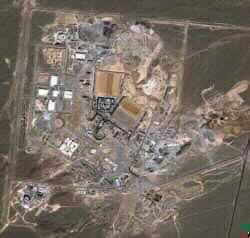Iran on Friday dismissed U.S. accusations that two nuclear plants it is building could be used to make secret nuclear weapons, but American officials expressed "grave concerns" and suggested the Iranians were trying to conceal some of the facilities. Washington's worries about Iran's nuclear activities came as North Korea announced it was restarting a mothballed nuclear reactor and United Nations arms experts combed Iraq in search of weapons of mass destruction. The three nations comprise President Bush's "axis of evil."
U.S. officials disputed assertions by Tehran that the two nuclear sites near the central Iranian towns of Natanz and Arak, seen in commercial satellite photographs, were for peaceful purposes.
"We don't have any hidden atomic activities. All our nuclear activities are for non-military fields," Iranian government spokesman Abdollah Ramazanzadeh said in Tehran, adding that U.N. inspectors had been invited to visit the sites.
But White House spokesman Ari Fleischer said, "We do continue to have grave concerns about it."
'ENRICHED URANIUM'
"The suspect uranium enrichment plant could be used to produce highly enriched uranium for weapons. The heavy water plant could support a reactor for producing weapons grade plutonium," Fleischer told reporters.
The State Department said Iran was trying to hide parts of the nuclear facility near Natanz by burying some of the buildings underground.
"You can tell that portions of the Natanz nuclear facility, the suspect uranium enrichment plant, ultimately will be underground," State Department spokesman Richard Boucher said.
The White House called on the Vienna-based U.N. nuclear watchdog, the International Atomic Energy Agency, to assess both facilities.
The disclosure raised new security challenges for Bush as he tries to disarm Iraq and contain North Korea, which announced this week that it would restart a nuclear reactor idled under the 1994 Agreed Framework that could be used to produce weapons-grade plutonium.
Iranian officials dismissed what they called "U.S. propaganda" and insisted international bodies were well briefed on Tehran's nuclear program.
The IAEA said it was aware of the facilities and planned to inspect them in February. "This is not a surprise to us," IAEA director general Mohamed ElBaradei said in Vienna.
The IAEA first raised the issue with Tehran in August, tipped off by satellite pictures, he said.
"Whether the program is for peaceful purposes or not, this is obviously for us to verify ... Iran affirmed that all their activities are for a peaceful purpose," ElBaradei said.
Iran invited IAEA inspectors after informing the agency in September of plans to build nuclear power plants and related fuel facilities over the next 20 years, IAEA spokesman Mark Gwozdecky told Reuters.
TECHNICAL EXPERTS
"The director general, with a team of technical experts, plans to make such a visit in February 2003," Gwozdecky said.
ElBaradei said the inspection visit by himself and IAEA technical experts had originally been planned for this month but was put off at Iran's request.
Iranian spokesman Ramazanzadeh told Reuters there was no obstacle for an IAEA inspection team to visit the sites.
"We have always said that our activities for peaceful usage of nuclear energy could be inspected," he said.
Ramazanzadeh insisted the plants were not sinister, saying the one near Natanz was intended to conduct research into radioactivity.
David Albright, president of the Washington-based Institute for Science and International Security (ISIS), told Reuters his organization was publishing its findings on the Iranian sites because it wanted the IAEA to inspect them.
ISIS reported on its Web site (www.isis-online.org/) that the complex near Arak appeared to include a plant to produce heavy water, a nuclear product that can be used either in civilian reactors or in the fuel cycle for making weapons.
"There is concern that this effort to obtain a complete fuel cycle is aimed at developing the capability to make separated plutonium and highly enriched uranium, the two main nuclear explosive materials," it said.
Nuclear experts said even if Iran's two new sites turned out to be heavy water and fuel enrichment plants, that could point to a nuclear power program just as well as to the development of nuclear weapons.
PHOTO CAPTION
A September 16, 2002 satellite image shows facilities in Natanz, Iran believed to be part of a previously unknown segment of Iran's nuclear program. Iran on Dec. 13 dismissed U.S. accusations that two nuclear plants it is building could be used to make secret nuclear weapons and said it had already invited U.N. inspectors to visit the sites. (ISIS, Digitalglobe via Reuters)
- Author:
& News Agencies - Section:
WORLD HEADLINES


 Home
Home Discover Islam
Discover Islam Quran Recitations
Quran Recitations Lectures
Lectures
 Fatwa
Fatwa Articles
Articles Fiqh
Fiqh E-Books
E-Books Boys & Girls
Boys & Girls  Articles
Articles










